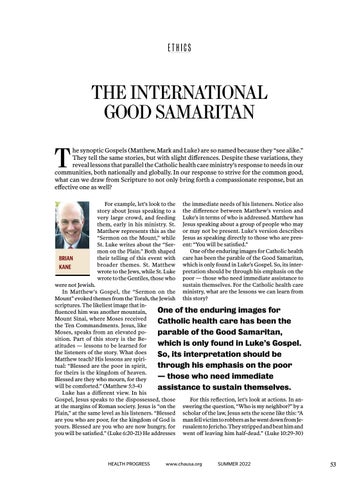ETHICS
THE INTERNATIONAL GOOD SAMARITAN
T
he synoptic Gospels (Matthew, Mark and Luke) are so named because they “see alike.” They tell the same stories, but with slight differences. Despite these variations, they reveal lessons that parallel the Catholic health care ministry’s response to needs in our communities, both nationally and globally. In our response to strive for the common good, what can we draw from Scripture to not only bring forth a compassionate response, but an effective one as well?
BRIAN KANE
For example, let’s look to the story about Jesus speaking to a very large crowd, and feeding them, early in his ministry. St. Matthew represents this as the “Sermon on the Mount,” while St. Luke writes about the “Sermon on the Plain.” Both shaped their telling of this event with broader themes. St. Matthew wrote to the Jews, while St. Luke wrote to the Gentiles, those who
the immediate needs of his listeners. Notice also the difference between Matthew’s version and Luke’s in terms of who is addressed. Matthew has Jesus speaking about a group of people who may or may not be present. Luke’s version describes Jesus as speaking directly to those who are present: “You will be satisfied.” One of the enduring images for Catholic health care has been the parable of the Good Samaritan, which is only found in Luke’s Gospel. So, its interpretation should be through his emphasis on the poor — those who need immediate assistance to sustain themselves. For the Catholic health care ministry, what are the lessons we can learn from this story?
were not Jewish. In Matthew’s Gospel, the “Sermon on the Mount” evoked themes from the Torah, the Jewish scriptures. The likeliest image that inOne of the enduring images for fluenced him was another mountain, Mount Sinai, where Moses received Catholic health care has been the the Ten Commandments. Jesus, like Moses, speaks from an elevated poparable of the Good Samaritan, sition. Part of this story is the Bewhich is only found in Luke’s Gospel. atitudes — lessons to be learned for the listeners of the story. What does So, its interpretation should be Matthew teach? His lessons are spiritual: “Blessed are the poor in spirit, through his emphasis on the poor for theirs is the kingdom of heaven. — those who need immediate Blessed are they who mourn, for they will be comforted.” (Matthew 5:3-4) assistance to sustain themselves. Luke has a different view. In his For this reflection, let’s look at actions. In anGospel, Jesus speaks to the dispossessed, those at the margins of Roman society. Jesus is “on the swering the question, “Who is my neighbor?” by a Plain,” at the same level as his listeners. “Blessed scholar of the law, Jesus sets the scene like this: “A are you who are poor, for the kingdom of God is man fell victim to robbers as he went down from Jeyours. Blessed are you who are now hungry, for rusalem to Jericho. They stripped and beat him and you will be satisfied.” (Luke 6:20-21) He addresses went off leaving him half-dead.” (Luke 10:29-30)
HEALTH PROGRESS
www.chausa.org
SUMMER 2022
53
